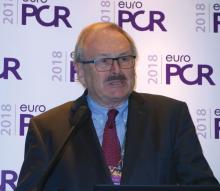Breakthrough in noninvasive assessment of multivessel CAD
REPORTING FROM EUROPCR 2018
PARIS – A completely noninvasive method of identifying functionally significant lesions in patients with triple-vessel coronary artery disease yielded results comparable to conventional invasive angiographic assessment accompanied by an intracoronary pressure wire, in a prespecified secondary analysis of the SYNTAX II study.
That noninvasive method uses fractional flow reserve calculated from computed tomographic angiography, Carlos Collet, MD, said at the annual meeting of the European Association of Percutaneous Cardiovascular Interventions.
The results were hailed as a harbinger of a coming era in which interventional decision making will be based entirely upon noninvasively acquired anatomic and physiologic data. Conventional diagnostic angiography is predicted to fall by the wayside, with resultant savings in time and cost as well as avoidance of the risks of percutaneous diagnostic angiography, which entails considerably more radiation exposure than does noninvasive CT angiography (CTA).
“We are on the verge of a major change,” said Patrick W. Serruys, MD, PhD, professor of cardiology at Imperial College London, who was the senior coinvestigator in the study. “I think that the next disruptive moment in cardiology will be the introduction of the new generation of multislice CT scans replacing conventional cineangiography in the next 5-10 years. For the interventional cardiologist, to have the results of a multislice CT scan the day before a procedure is a wonderful bonus. You know in advance what you’re going to see, you can develop your treatment strategy, and you can spare contrast.”
Compared with conventional invasive angiographic assessment with the use of an intracoronary pressure wire to measure iFR, the noninvasively calculated SYNTAX II score had 95% sensitivity and 61% specificity for detection of functionally significant stenosis, with a positive predictive value of 81% and a negative predictive value of 87%. And this was achieved using older scanners and software considerably less accurate than today’s rapidly evolving state of the art, Dr. Collet noted.








